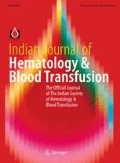Abstract
Bombay phenotype, H partially deficient non secretor phenotype and Para-Bombay phenotype are rare blood groups with deficiency or absence of H antigen. A 52-year-old female with Chronic suppurative otitis media was referred to our hospital. The primary serologic results of ABO blood typing were discrepant in forward and reverse grouping. Further, the saliva secretion tests, the pedigree studies and the sequence analysis were performed to confirm the rare phenotype. The patient was diagnosed as a variant H-deficient phenotype, secretor (para-bombay). Red cells of the patient have no H antigens, and it’s a very interesting thing that there were two opposite results in the saliva test by using different anti-H. The test showed that H substances were present in the saliva by using anti-H from Libo Biotechnology Co, while which were absent by using anti-H from Shanghai blood center. The patient’s Lewis phenotype was Le (a−b+). Anti-HI was present in the sera of her. The sequence of the ABO gene of the patient was 261delG and 467C>T heterozygote by direct DNA sequencing and was assigned as A102/O01. There were two mutations of the patient’s FUT1, 328G/A and 658C/T, which were identified by DNA sequencing compared with the reference sequence (GenBank, NG_007510.2). In this case, we report a patient with particular H-deficient phenotype, secretor, which showed opposite results in the saliva test by using anti-H from different sources. We suspect that it is a variant of para-Bombay phenotype.


References
Kelly RJ, Rouquier S, Giorgi D et al (1995) Sequence and expression of a candidate for the human Secretor blood group alpha(1,2)fucosyltransferase gene (FUT2). Homozygosity for an enzyme-inactivating nonsense mutation commonly correlates with the non-secretor phenotype. J Biol Chem 270:4640–4649
Rouquier S, Lowe JB, Kelly RJ et al (1995) Molecular cloning of a human genomic region containing the H blood group alpha(1,2)fucosyltransferase gene and two H locus-related DNA restriction fragments. Isolation of a candidate for the human Secretor blood group locus. J Biol Chem 270:4632–4639
Daniels G (2002) Human blood groups, 2nd edn. Blackwell Science, Malden
Geng W, Gao HH, Zhang LW (2016) Serological characteristics and family survey of 3 cases of H-deficient blood group. Zhongguo shi yan xue ye xue za zhi 24:913–917
Maeda H, Ohshima T, Takayasu T, Tanaka N (1985) A case of para-Bombay phenotype Bhm (OBHm). Nihon Hoigaku Zasshi 39:209–213
Malhotra S, Dhawan HK, Jain A et al (2014) Acute hemolytic transfusion reaction in a patient with bombay phenotype: implications for ABO grouping. Indian J Hematol Blood Transfus 30:108–110
Shrivastava M, Navaid S, Peethambarakshan A et al (2015) Detection of rare blood group, Bombay (Oh) phenotype patients and management by acute normovolemic hemodilution. Asian J Transfus Sci 9:74–77
Seifinejad A, Taei A, Totonchi M et al (2010) Generation of human induced pluripotent stem cells from a Bombay individual: moving towards “universal-donor” red blood cells. Biochem Biophys Res Commun 391:329–334
Kelly RJ, Rouquier S, Giorgi D et al (1995) Sequence and expression of a candidate for the human Secretor blood group alpha(1,2)fucosyltransferase gene (FUT2). Homozygosity for an enzyme-inactivating nonsense mutation commonly correlates with the non-secretor phenotype. J Biol Chem 270:4640–4649
Dipta TF, Hossain AZ (2011) The Bombay blood group: Are we out of risk? Mymensingh Med J 20:536–540
Le Pendu J, Gerard G, Vitrac D et al (1983) H-deficient blood groups of Reunion island. II. Differences between Indians (Bombay Phenotype) and whites (Reunion phenotype). Am J Hum Genet 35:484–496
Su Y, Wei TL, Yu Q et al (2007) Molecular genetic analysis of FUT1 and FUT2 gene in para-Bombay Chinese: a novel FUT1 allele is identified. Zhonghua Yi Xue Yi Chuan Xue Za Zhi 24:520–523
Xu DY, Deng G, Huang DD, Zhao WJ (2011) Mutational analysis for FUT1 gene in two cases with para-Bombay blood type. Zhonghua Yi Xue Yi Chuan Xue Za Zhi 28:694–698
Sun CF, Lo MD, Lee CH, Chu DC (2000) Novel mutations, including a novel G659A missense mutation, of the FUT1 gene are responsible for the para-Bombay phenotype. Ann Clin Lab Sci 30:387–390
Zhang X, Li J (2016) Ael subgroup due to alpha-1,3-N-acetylgalactoseaminotransferase gene 467C>T and 804insG variants. Zhonghua Yi Xue Yi Chuan Xue Za Zhi 33:526–529
Lin F, Sun C, Wang H et al (2015) Study of a case with homozygous 35C>T and 658C>T mutations of FUT1 gene leading to a para-Bombay phenotype. Zhonghua Yi Xue Yi Chuan Xue Za Zhi 32:834–836
Luo G, Wei L, Wang Z et al (2013) The summary of FUT1 and FUT2 genotyping analysis in Chinese para-Bombay individuals including additional nine probands from Guangzhou in China. Transfusion 53:3224–3229
Yamamoto F, Clausen H, White T et al (1990) Molecular genetic basis of the histo-blood group ABO system. Nature 345:229–233
Kaneko M, Nishihara S, Shinya N et al (1997) Wide variety of point mutations in the H gene of Bombay and para-Bombay individuals that inactivate H enzyme. Blood 90:839–849
Darabi K, Makar RS (2008) Acute hemolysis of transfused A2 red cells by an auto-HI antibody. Transfusion 48:964–968
Campbell SA, Shirey RS, King KE, Ness PM (2000) An acute hemolytic transfusion reaction due to anti-IH in a patient with sickle cell disease. Transfusion 40:828–831
Irani MS, Richards C (2011) Hemolytic transfusion reaction due to anti-IH. Transfusion 51:2676–2678
Author information
Authors and Affiliations
Corresponding author
Ethics declarations
Conflict of interest
The authors declare that they have no conflict of interest.
Ethical Approval
All procedures performed in studies involving human participants were in accordance with the ethical standards of the institutional and/or national research committee and with the 1964 Helsinki declaration and its later amendments or comparable ethical standards.
Rights and permissions
About this article
Cite this article
Song, M., Zhao, S., Jiang, T. et al. A Very Rare Case with Particular H-deficient Phenotypes. Indian J Hematol Blood Transfus 34, 788–791 (2018). https://doi.org/10.1007/s12288-018-0915-3
Received:
Accepted:
Published:
Issue Date:
DOI: https://doi.org/10.1007/s12288-018-0915-3

